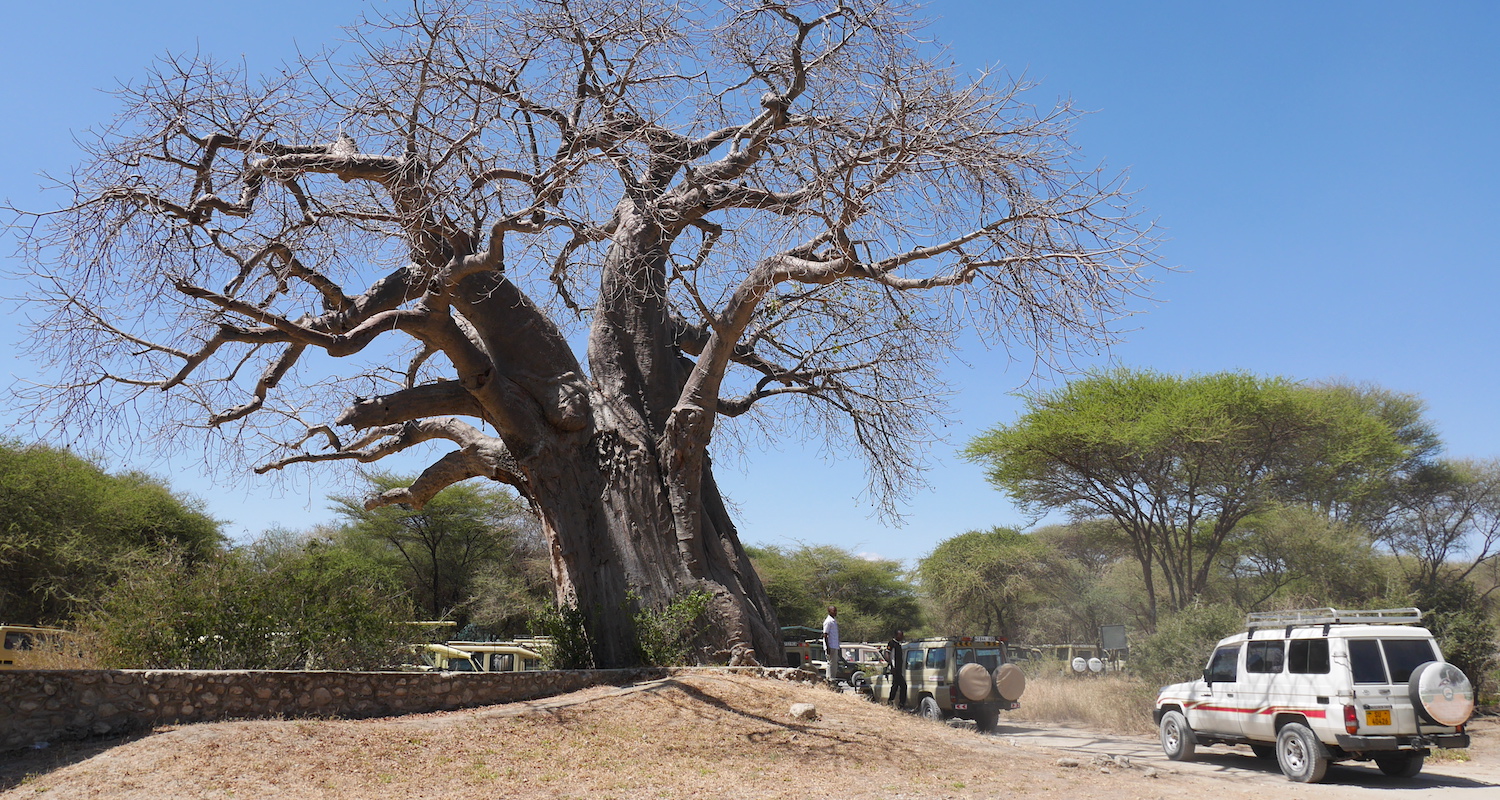The baobab seemed to stretch and squat simultaneously. Its boney fingers, numbering in the thousands, reached upward and scratched the underbelly of the sky. Its trunk, on the other hand, collected itself low to the ground, barrel-like, and for good reason. The baobab tree (of the genus Adansonia) is a succulent. It is perfectly adapted for life on the African savanna. The trunk absorbs and stores water, a feature that accounts for its tremendous girth. Stories about this iconic "tree of life" or "upside down tree" with elephant-like skin have been shared around campfires for centuries.
Legend has it that the baobab tree was planted upside down because its limbs look like roots. The swollen trunk of the baobab can hold up to 120,000 liters of water.
This particular specimen marked the northern entrance to Tanzania's Tarangire National Park. Saidi pulled into a parking spot and went to get the necessary permissions at the ranger station. We found Mo and Rachael, fellow Kili-climbers who had come in another vehicle, and ate lunch together. Afterwards we said our goodbyes. Their African adventure was taking them in a different direction; we would not see them again.
After lunch, we said goodbye to Rachael and Mo. They were headed in a different direction.
Safari rigs are functionally built machines. They are sturdy and stiff with high clearance, roll bars, spare tires, storage space, and a roof that can be elevated so that passengers can stand or sit. Drivers are more than wheelmen, they are trained as spotters and guides.
Saidi returned to our rig with the papers. We hopped in and helped lift the roof. Saidi pulled out of the lot but didn't go far. On the edge of the compound was a troop of vervets (Allenopithecus Nigroviridis). Their turquoise-colored testicles (hence the nickname, "blue balled monkeys") stood out against their grey coats and elicited the usual snickers. No doubt their presence in the acacia trees near the station was tied to their habit of stealing lunches from tourists. They are more like blue bandits! I thought.
Vervets scampered in the trees around the Ranger Station.
We left the monkeys behind and drove deeper into the park. The track we followed was heavily rutted but baked hard by the sun. It wasn't long before we came upon a herd of impalas (Aepyceros melampus). Their spiral horns, cinnamon-colored backs, and white-and-black faces were beautiful. They were content to graze as we watched and photographed from our wheeled platform.
Impalas grazing.They are a graceful mid-sized member of the antelope family.
We moved on and found our first watering hole. The water was muddy and brackish, its surface no larger in the size of a football field; it was not much as far as ponds go. But the wild animals collected here by the hundreds. I had to remind myself that this was not a zoo. It is a segment along a natural migratory path. I remembered Saidi's observation about visiting Africa in the dry season: "We go to the water. That is where the animals are."
We approached our first waterhole. There were easily a hundred animals here.
Zebra and wildebeest were everywhere.
We stayed by the waterhole for some time. Initially, there was a whirl of cameras and excited whispers. In time, the cameras came and down and we found ourselves content to quietly observe this panoramic display. Zebras (Equus Burchelli) and Blue Wildebeests (Connochaetes Taurinus) drank the muddy water, flicked their tails, rolled in the dust, and fussed with each other. It may have just been in my head, but somewhere I could hear the soundtrack of "The Lion King" playing.
And speaking of the Lion King, as we drove off, pumba and his gang (Phacochoerus Africanus) trotted by.
The warthogs were skittish. We couldn't get close and my lens was not big enough to capture their ugly faces.
Tarangire Park is famous for elephant displays (Loxodonta Africana). Herds-sizes here are unrivaled in northern Tanzania. Up to 600 may be seen at one time. Unfortunately, this would not be our experience. We spotted three moving in the distance but that was all. Again, I lamented my short-lensed camera.
Three elephants crossed our path.
Other identified animals included an ostrich, the world's largest bird (Struthio camelus), the snake-fighting secretarybird (Sagittarius serpentarius), and Grant's Gazelle (Gazella Granti).
Saidi thought that we might find elephants near the river so we took a shot and spent some time cruising along a bluff overlooking the Tarangire. No luck.
The Tarangire River runs like an artery through the center of the Park. We stopped at this bluff hoping to see elephants. We were given a fine view, but it did not include elephants.
Still, all in all, it was a very good day. We returned to the park entrance and lowered the lid. Our evening drive would take us out of the Great Rift Valley and into the mountains. Promises of even more wildlife came with the mention of one magical phrase: Ngorongoro Crater
Wildebeests (or gnus) lounge in the sun. Nearby are two large secretarybirds, a long-legged raptor that feeds mostly on snakes. Note the iconic outline of the baobab trees in the distance.










